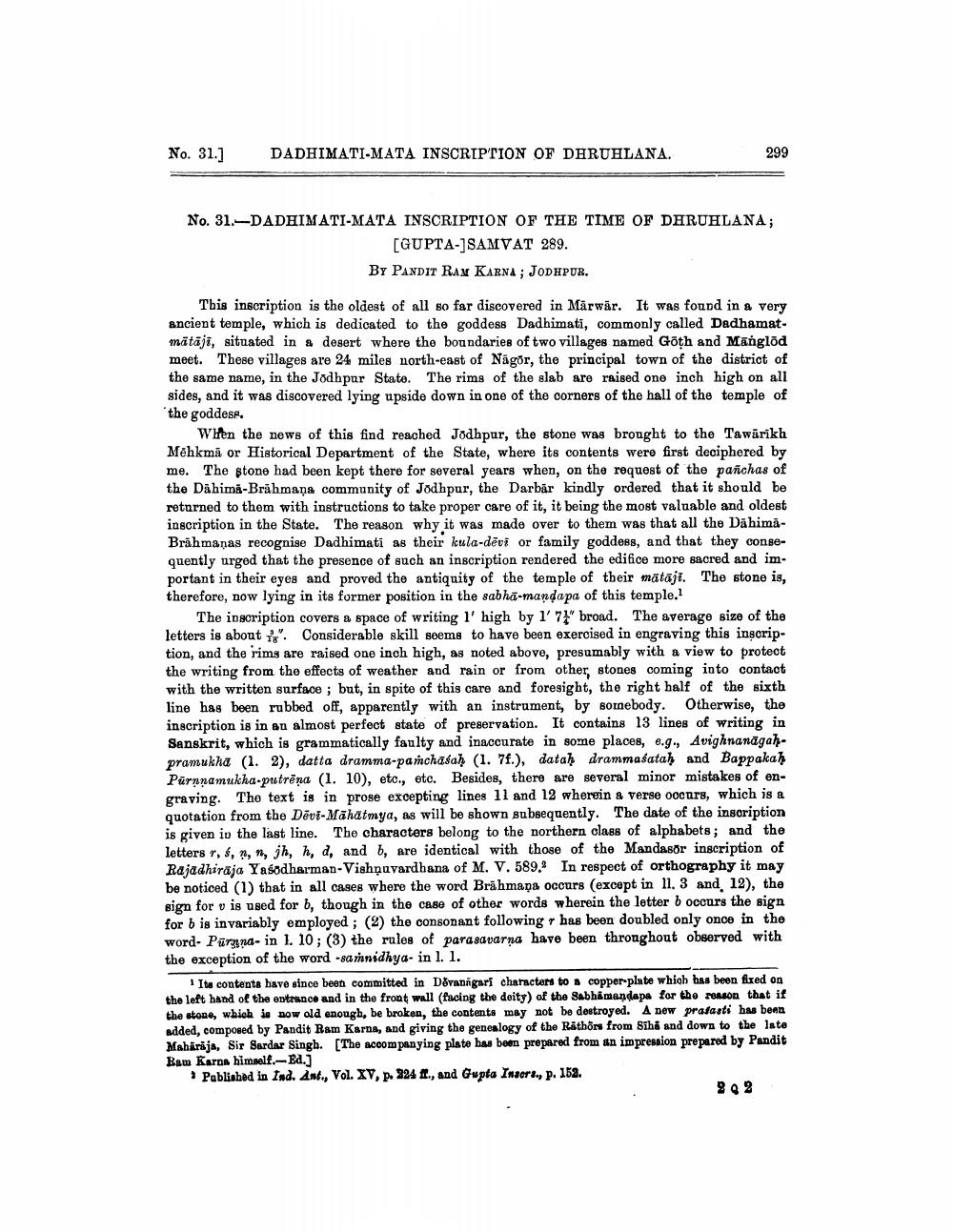________________
No. 31.]
DADHIMATI-MATA INSCRIPTION OF DHRUHLANA.
299
No. 31.—DADHIMATI-MATA INSCRIPTION OF THE TIME OF DHRUHLANA;
[GUPTA-]SAMVAT 289. By PANDIT RAM KARNA; JODHPUR.
This inscription is the oldest of all so far discovered in Märwär. It was found in a very ancient temple, which is dedicated to the goddess Dadhimati, commonly called Dadhamatmātāji, situated in a desert where the boundaries of two villages named Goth and Mānglod meet. These villages are 24 miles north-east of Nāgör, the principal town of the district of the same name, in the Jodhpur State. The rims of the slab are raised one inch high on all sides, and it was discovered lying upside down in one of the corners of the hall of the temple of the goddess.
When the news of this find reached Jodhpur, the stone was brought to the Tawārikh Mehkma or Historical Department of the State, where its contents were first deciphered by me. The stone had been kept there for several years when, on the request of the pañchas of the Dahimã-Brāhmaṇa community of Jodhpur, the Darbār kindly ordered that it should be returned to them with instructions to take proper care of it, it being the most valuable and oldest inscription in the State. The reason why it was made over to them was that all the DähimaBrāhmaṇas recognise Dadhimati as their kula-dēvi or family goddess, and that they congequently urged that the presence of such an inscription rendered the edifice more sacred and important in their eyes and proved the antiquity of the temple of their mataji. The stone is, therefore, now lying in its former position in the sabhā-mandapa of this temple.
The inscription covers a space of writing l' high by 1' 71' broad. The average size of the letters is about ". Considerable skill seems to have been exercised in engraving this inscription, and the rims are raised one inch high, as noted above, presumably with a view to protect the writing from the effects of weather and rain or from other stones coming into contact with the written surface ; but, in spite of this care and foresight, the right half of the sixth line has been rubbed off, apparently with an instrument, by somebody. Otherwise, the inscription is in an almost perfect state of preservation. It contains 13 lines of writing in Sanskrit, which is grammatically faulty and inaccurate in some places, e.g., Avighnanāgah pramukha (1.2), datta dramma-panchasah (1.7.), datah drammasatah and Bappakah Pūrnnamukha-putrēna (1. 10), etc., etc. Besides, there are several minor mistakes of engraving. The text is in prose excepting lines 11 and 12 wherein a verse occurs, which is a quotation from the Devi-Māhatmya, as will be shown subsequently. The date of the inscription is given in the last line. The characters belong to the northern class of alphabets; and the letters , 6, 7, 9, jh, h, d, and b, are identical with those of the Mandasör inscription of Rajadhiraja Yasodharman-Vishņuvardhana of M. V. 589. In respect of orthography it may be noticed (1) that in all cases where the word Brāhmaṇa occurs (except in 11. 3 and 12), the sign for v is used for b, though in the case of other words wherein the letter b occurs the sign for b is invariably employed ; (2) the consonant following r has been doubled only once in the word- Pūryna-in 1. 10; (3) the rules of para savarna have been throughout observed with the exception of the word -samnidhya. in l. 1.
Its contents have since been committed in Dovanigari characters to a copper-plate which has been fixed on the left hand of the entrance and in the front wall (facing the deity) of the Sabhimandapa for the reason that if the stone, which is now old enough, be broken, the contents may not be destroyed. A new prasasti has been added, composed by Pandit Ram Karna, and giving the genealogy of the Rathon from Siha and down to the late Mahäräja, Sir Sardar Singh. [The accompanying plate has been prepared from an impression prepared by Pandit Ram Kards himself.Ed.]
Pablished in Ind. Ant., Vol. XV, p. 324 1., and Gupta Inaers., p. 152.




